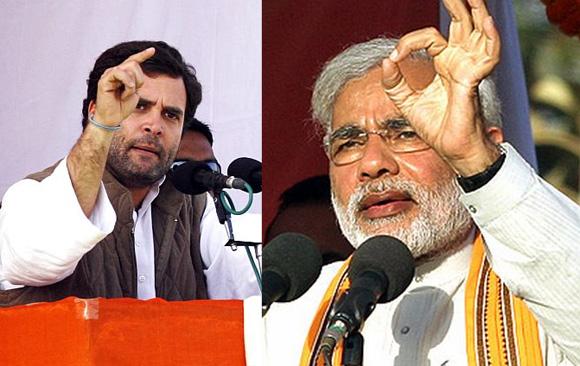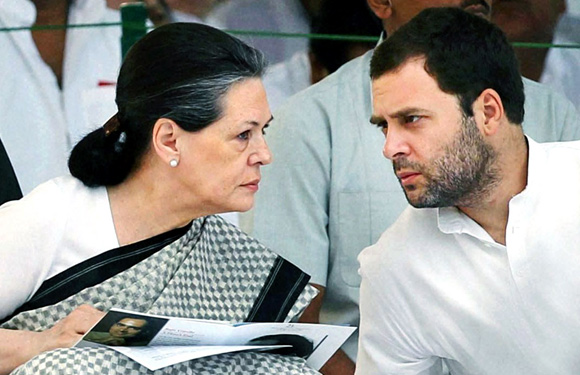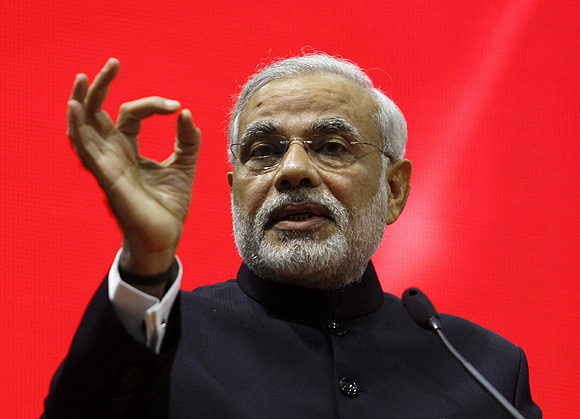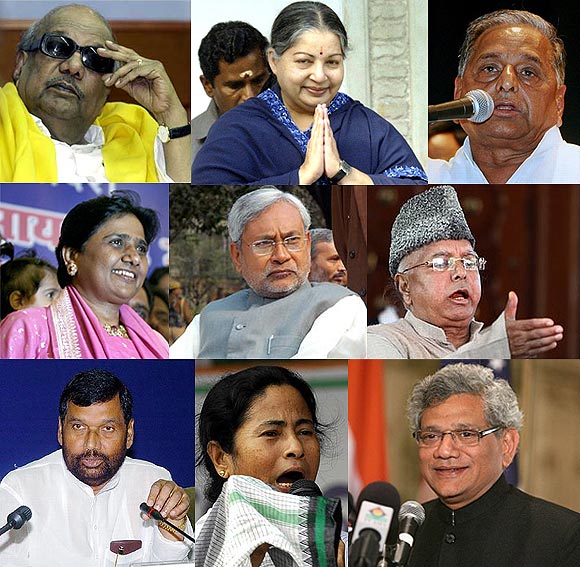 | « Back to article | Print this article |
Road to 2014: Rahul, Modi share a COMMON challenge
Can Rahul Gandhi and Narendra Modi win allies for their parties if made the prime ministerial candidates for the 2014 Lok Sabha elections? Saroj Nagi analyses
Rahul Gandhi's elevation from Congress general secretary to vice president and a possible prime ministerial candidate in the 2014 Lok Sabha elections has been on the cards for some time now. And while his appointment and speech at the recently concluded Chintan Shivir in Jaipur has enthused Congress cadres, the big question remains: Will allies accept his for the top post?
The Bharatiya Janata Party, too, could find itself in a similar situation if it projects Gujarat Chief Minister Narendra Modi as its face for the Lok Sabha polls.
The vital difference of course would lie in two facts -- one, that while the acceptance of Rahul's elevation would be complete and total within the Congress which banks on and draws sustenance and energy from the Nehru-Gandhi brand, it may not be so insofar as Modi's anticipated elevation is concerned within the BJP.
Two, that while the reservation of potential allies against Modi would be on ideological lines, the hesitation, if any, in accepting Rahul's stewardship of an alliance would lie in his lack of experience, be it in governance, administration or political management.
So here is a situation building up where the elevation of the two main candidates from two major political formations who are likely to play critical roles in the campaign for the 2014 general elections: Even if they are not projected as prime ministerial candidates at this juncture they may impel existing and potential allies into a rethink and set up the terms and conditions of future relationships unless they choose to coalesce into a hydra-headed third front.
Not surprisingly, neither party has so far openly spoken of who their prime ministerial candidate would be in 2014.
Since much would depend on the number of seats each party gets in the elections, there would be tremendous competition between the two major outfits to emerge as the single largest party and the single largest pre-poll formation to get an invite from the President to explore the possibility of forming a government if there is a fractured mandate as most people believe would happen. Efforts would be on even before the elections and more intensely after it to get supporters outside the alliance network.
Click NEXT to read further...
Sonia to play role of elder statesman
Challenge before Rahul and the Congress
While Rahul is known to be in favour of the Congress going it alone, the party is for gathering allies in a bid to come to power at the Centre.
The main challenge before the party will be to consolidate its relations with its existing allies and bring on board new allies and work up its image.
The Congress has, under the leadership of Prime Minister Manmohan Singh and party president Sonia Gandhi, lost a number of allies since it came to power in 2004 and then again in 2009. More recent quitters include the Trinamool Congress, the Jharkhand Vikas Morcha and All India Majlis-e-Ittehadul Muslimeen, with the first two capable of shifting support to the BJP-led National Democratic Alliance.
So, what Sonia and Dr Singh could not hold on to Rahul would be expected to bring in, as he assumes greater charge of the organisation in the coming days. The Congress chief will perhaps increasingly playing the role of an elder statesman.
The big question here would be whether leaders who are senior to Rahul in politics, administrative experience and governance would accept his leadership in an alliance in which they would have to play junior partners and players?
Will Nationalist Congress Party's Sharad Pawar, who has often been reported to be dreaming of the top job in a fluid political situation play second fiddle to Rahul or will be oversee a generational shift in his party by passing on his mantle to his daughter Supriya Sule in 2014? Will Dravida Munnetra Kazhagam's M Karunanidhi, Samajwadi Party's Mulayam Singh Yadav or Bahujan Samaj Party's Mayawati accept him at the helm?
Will the Trinamool Congress return to the UPA fold under a Rahul dispensation? Will Biju Janata Dal's Naveen Patnaik mortgage his party to a coalition led by Rahul? And more importantly, will Janata Dal-United leader Nitish Kumar -- even if he snaps ties with the BJP after Modi takes centrestage -- accept the Nehru-Gandhi scion for a leader?
These and many other questions would also be contingent on the role that Sonia would play in the run-up to the 2014 elections and more importantly on the performance of the party in the nine state assembly elections in 2013 including in Congress-ruled states like Delhi and Rajasthan and BJP-ruled states like Madhya Pradesh, Karnataka and Chhattisgarh. As the main face of the party now, Rahul would be on test in these elections.
Click NEXT to read further...
Rahul's image as youth icon is dented
The 42-year old leader comes with his baggage of positives and negatives. He is young, determined, focused on how he wants to run the party, has no taint against his name, enjoys the advantage of being a Gandhi and though not a great orator, conveys a sincerity of purpose and conviction that is refreshing and often heartwarming as witnessed from his speech at the Congress' Jaipur conclave on Sunday.
As the party's vice president, he will have to contend with several challenges: reviving/strengthening the organisation, rebuilding social alliances, scouting for allies, establishing a connect between the party leadership and workers and restoring the party's image and credibility badly dented by scams, misgovernance and price rise.
But his track record as a performer has left much to be desired so far. He delivered during the 2009 Lok Sabha polls in Uttar Pradesh, but failed when it came to the assembly elections in that state and in Bihar and maintained a low profile in the Gujarat state elections where Modi successfully won a third term in office. He still appears to be a reluctant leader, failing to keep up a sustained campaign once the elections are over in crucial states like Uttar Pradesh and Bihar where the Congress is desperately looking for a revival.
He was projected and seen as a "youth icon" in the larger polity but his failure to articulate his opinions on crucial issues or empathise with the slogan shouting youth, especially during the campaign against the gang rape of a young paramedic in Delhi, has dented that image. Placards were raised about his absence from the scene.
There is also talk that his attempts at democraticising and broadbasing the Youth Congress and National Students Union of India have led to aberrations like ushering of "money culture" into elections and indiscipline among the elected members riding high on the fact that they have come through elections and not nominations.
Click NEXT to read further...
Rahul not in a position to talk about his governance
Unlike most of the other aspirants for the PM's post in 2014, Rahul would not be in a position to talk about his role in governance.
Other than making some interventions with the government -- like calling for a farm loan waiver, a Bundelkhand package or extending the Mahatma Gandhi National Rural Employment Guarantee Act, with ministers giving him credit also for the direct cash transfer benefit, the land acquisition bill and some other legislations -- he cannot make claims like Modi, Nitish Kumar, Shivraj Singh Chauhan, Raman Singh, Naveen Patnaik, J Jayalalithaa or for that matter, the Congress party's own Sheila Dikshit. He would have to bank on Sonia's determination to push for the passage of legislations like the Women's Reservation Bill and the Food Security Bill.
To overcome this shortcoming of governance in the 15 months left for the Lok Sabha polls, Rahul has to take on a more proactive role in projecting that he is steering the UPA government, sustaining his ground level campaigns and engaging his party workers.
And even though he and Sonia have often said that the party is not in the pursuit of power, he will have to reinvigorate the Congress so that it can get close to the 200 mark in the 543 member Lok Sabha -- a mark that will attract the support of hesitant and dithering allies who want to back the winning horse.
Click NEXT to read further...
Modi's big challenge: To be accepted as national leader
The BJP is likely to find itself in a similar situation, particularly if the spotlight is on Modi for the 2014 polls. The Gujarat chief minister, who carries the millstone of the 2002 riots round his neck, would find it difficult to gain the confidence of the minority community. And this in turn will act as a drag on his attempts to emerge as a credible leader on the national scene.
Because of the riot taint and its implications on the minority vote, Nitish Kumar has often made his reservations public about the Gujarat chief minister and his party has often dared the BJP to name its prime ministerial candidate.
The BJP's tested allies like the Shiv Sena and the Akali Dal may not be averse to Modi. Given the Gujarat chief minister's good equations with J Jayalalithaa there is speculation of closer ties between the two parties.
J Jayalalithaa had in fact attended his swearing-in ceremony. So did Shiv Sena's Uddhav Thackeray and its breakaway faction's Raj Thackeray for that matter.
The Gujarat CM could also try to restore the broken links with B S Yeddyurappa, the former Karnataka CM, who has now floated his own outfit.
Modi and Pawar are said to share a good chemistry though this is unlikely to lead to any political or electoral understanding, at least openly.
But it could be a long haul for the BJP to scout for fresh allies if Modi is brought into national focus as the polity is poised to get sharply divided along the secular-communal line, with BJP baiters set to raise the issue of the Gujarat riots and the anti-Muslim stand of the saffron brigade. The first signs of it are already there, with the Congress appealing to secular, like-minded and progressive forces to join hands with it and Union Home Minister Sushilkumar Shinde using the Jaipur conclave to attack the BJP-RSS for fomenting "saffron terror".
Click NEXT to read further...
Modi to contest Lok Sabha seat from Lucknow?
Notwithstanding the communal-secular debate that sharpened with the 2002 Gujarat riots and became an important part of the Congress's strategy to win allies, several parties have shown a proclivity to switch between the NDA and the UPA, with bouts of equidistance for some. They include, among others, the Trinamool Congress, the Bahujan Samaj Party, the Telegana Rashtra Samiti, the National Conference, the Lok Jan Shakti Party, the Jharkhand Mukti Morcha, the DMK, the Marumalarchi Dravida Munnetra Kazhagam, the Pattali Makkal Katchi and even the AIADMK.
No one can be sure which way these parties would turn in 2014. The answer would perhaps lie in the number of seats the Congress, the BJP, the Left and each of these parties win in the elections and the kind of alternative that they see as emerging after the polls. Hard political reality has a way of papering over any queasiness they may have, as they strive to safeguard their political relevance and survival and become a part of one coalition or the other in order to share power.
After winning three terms as chief minister, Modi's big challenge when he comes into national politics would be whether he would be accepted as a national leader, whether his past would impact his future and whether his graduated slogans of Gujarat asmita and vibrant Gujarat, as he moved from Hindutva to development, would find resonance in other parts of the country.
His foray outside Gujarat -- for example during the Himachal Pradesh assembly elections -- was not successful. Not surprisingly, there is speculation that in a bid to reinvent himself, Modi could contest the Lok Sabha elections from Lucknow, the seat once represented by Atal Bihari Vajpayee, and thereby build an emotional connect with the local electorate, the liberal Hindu and a young and aspirational middle class that places its faith on clean and effective leadership and politics.
He would seek to combine this with his no-nonsense and tough image, his ability to deliver on development despite the gaping holes on the social development front and the absence of any corruption charge against him. Will he succeed? No one knows. But his presence would help to polarise the atmosphere, consolidate the BJP supporters at the ground level and divide the minority vote between the non-BJP parties as has been happening so far.
But this is clearly not enough. Modi would also be aware that he can become a player in 2014 only if he can help the party get as close as possible to the 200 mark to establish his hold, win allies among fence sitters and try and push the party nearer to forming a government at the Centre.
Click NEXT to read further...
Every Third Front leader sees himself as PM candidate
The Third Front
Besides the UPA and the NDA, the third front would also be trying to set up its own shop. But the roadblock for a non-Congress, non-BJP-led front is that the Left parties -- which have been the cementing force for such a combine -- are presently a weakened lot. Though they are still to recover from their electoral debacle in the 2011 West Bengal assembly, they can still draw heart from the fact that even during their worst performance they have managed to garner 42 per cent of the votes.
Secondly, there are contradictions between regional parties in states, which could provide the ground for the growth of a Third Front. The Trinamool Congress will not be a part of a combine, which has the Left parties in it; BSP leader Mayawati will not be an active partner in an alliance which has Samajwadi Party chief Mulayam Singh Yadav in it.
Jayalalithaa's AIADMK and Karunandhi's DMK cannot co-#8707 RJD's Lalu Prasad and LJP's Ram Vilas Paswan will stay away from a grouping that includes JD-U's Nitish Kumar. This is the situation involving the four major states of West Bengal, UP, Bihar and Tamil Nadu, which account for almost 200 parliamentary seats. In most of the other states, the battle is essentially bipolar between the Congress and the BJP/or some other regional party.
Thirdly, the ambition of the leaders of parties who can be part of the Third Front is high and each of them sees himself/herself as a potential prime ministerial candidate, especially if there is a deeply fractured mandate and a fluid political situation.
Unlike the Congress-led UPA or the BJP-led NDA which would need to be closer to the 180-200 mark to rustle up allies, the Third Front is aware that even if does not touch the 200 mark it can still hope for a repeat of the 1989 or the 1996 scenario where a group of non-BJP, non-Congress parties formed the government with the backing of both or one of the two major formations.
In a badly fractured verdict, the backing for such a government can come either from the BJP or the Congress.
Click NEXT to read further...
TOP photo features of the week
Click on MORE to see another set of PHOTO features...







